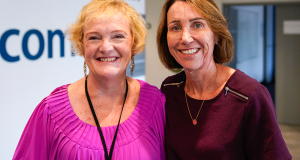By Richard Moor, Children Youth and Families Pastor, Southside Uniting.
“Our church is getting older”, or “We don’t have any young people.” We are used to these comments. You have probably been aware for a while that there seems to be a problem with our churches connecting with young people. The book points out that church numbers are declining, and the number of young people is declining. The statistic you might not have noticed so clearly is that in the US, about 50% of young people in High School will drop away from faith as they move into college. In Australia, this is about 70% that we lose from High School to University. We know the problem; we know the changed field of play (or hopefully, we do). So how do we change it? That’s what this book attempts to give us some ideas about. How do we have a church which is growing young instead of old? How do we engage young people?
Fuller Institute did some research (this book follows on from research they did around children’s faith and helping them to stay in the church called Sticky Faith, which is well worth a read). Interestingly for me, they came up with a list of things that don’t make a difference, the sort of things that have been suggested to me over the years to try. It’s not about the size of the group, the location, the age of the church, the denomination (or lack of), an off-the-charts cool quotient, a big modern building, a big budget, or a “contemporary” worship style. Watered-down teaching style or hyper-entertaining ministry program. Maybe you have heard some of those, or the lack of some of these has stopped you from trying to engage young people. The good news is they don’t really matter. You can have a great flourishing ministry with youth without these things.
So what is it that matters? They suggest six key factors which will help your church to grow young. Before we jump in, they do have a cautionary note that I think is important for all of us when reading these sorts of books. They note that they share ideas from 250 different congregations that are doing well, and it would be easy for that to depress us. They say, “Don’t take the best of those places and compare with the worst of what you are doing… Growing young means starting where you are.” This book sets out a path to go, and we need to start somewhere.
1) Unlock keychain leadership. What is the power you create when you give a young person the keys to the church because they have a position in the church? They challenge us to think about how we might be giving young people authority and meaningful places of ministry in the church. Of course, this is not about giving them a position and then walking away, but rather we walk alongside young people and support them in their ministry and leadership. This is a challenge for the church; how do we allow young people to step up, and how do we step aside? Over many years I have seen as you give young people some responsibility, they step up to it, and connections grow.
2) Empathize with today’s young people. This is about listening to the issues of young people, being present to them and being open to conversation. This is not as hard as it seems because we are all asking the same things. “Who am I?” “Where do I fit?” “What difference do I make?”. As we engage young people and hear about their life, we build important connections. Young people are not just numbers for us to celebrate, but they are each important. We need to listen and invest in them to show how they matter.
3) Take Jesus’ message seriously. This is not about giving a simplified explanation of faith that has led to the problem of moralistic therapeutic deism. This is about focussing on Jesus. Allow his words to challenge the young people. Dig into the Bible and explore together. It is wonderful to explore Jesus with young people, to help them to see the things that he did and what was important to him, rather than just what some book tells us we need to know.
4) Fuel a warm community. One of the keys to young people sticking is relationships with older people in the church. “By suggesting that churches need to grow warmer, we don’t mean adults should be nice to young people. Nice doesn’t cut it. It isn’t how Jesus responded to people, and it falls short of the depth we saw in congregations.” We need to move away from a focus on programs to a focus on relationships. How are we helping our young people to build connections with others in the church? They note this is the point where many churches fail, and the kids move out. It is so important for us to be moving from programs to relationships. This has been a strong point for Andrew Root (you should check out some of his books), and I have seen how real warm relationships in young people change them.
5) Prioritize young people (and families) everywhere. We need to be demonstrating that young people are a priority to us with time and funding. We need to get serious about this type of ministry. We need to also demonstrate that they are important by engaging them in ministry and finding out what they want and can do. And it means working with families because families are crucial to the faith development of young people. It’s easy to say we want more young people, but how much are we willing to focus on them? Is it just that we want them to save the institution? Rather how do we really invest in them and what they need?
6) Be the best neighbours. How are we connecting with the community, the culture and the world around us? Are we hiding away, or are we trying to make the world a better place? Our young people want to be involved in the world, so we must ask how we are supporting them in that. What causes do we need to get involved with because our young people are?
Please don’t think, “Yay, I have the summary of each; I don’t need to read the book”. Each chapter gives you some questions to ask your own congregation to assess how you are going. It also gives you some action points to work on in that area. And it’s not just one or two, but there are a few pages of ideas and how they might play out. We all need some inspiration, and we need some ideas about how to move forward.
But wisely, the book points out that there is no silver bullet. You need to work out what is best for your situation. And don’t start working on them all; choose one area to develop. Pick one or two of the action ideas or allow them to inspire your own idea. Start to work on those. When it is going well, move on to the next. This is a journey; there is no overnight solution. But this book will help us to have some ideas of how we can work bit by bit.
It might be helpful to note that this book gives us six areas. This is how they chose to group it. Of course, you can find others. I recently read this book and heard Jake Mulder speak when we came together as Southside. As we gathered the youth leaders, we agreed we should develop a framework to base our ministry on to show what is essential. I suggested this. A few churches already used the Here2Stay framework, so we stuck with that. Hopefully, you can see the two overlap. Keychain leadership links with responding with compassion and Serving in mission. Empathy today links with the foundation of Generational connections. Jesus’ message links with God’s big story and encounters with Jesus. Warm relationships link with Generational connections and Mentoring and Coaching. Prioritize everywhere links in most of them, especially the foundation of Family Household Nurture. Best Neighbours links to Respond with compassion.
So we are working with Here2Stay, but the Growing Younger is just another way of looking at the same things, and it helps us on our journey of changing our church. I hope the book will give you ideas about what you might do in your local context. There is something that every church can do.
Why not join us 7-8 pm next Tuesday, May 2, to discuss the book at our online discipleship book club? All are welcome; joining us for this discussion doesn’t require you to attend any future gatherings!
Click here to register and receive the link to the meeting, and for further information, don’t hesitate to get in touch with Paul Wetzig at paul.wetzig@ucaqld.com.au
 JourneyOnline
JourneyOnline







